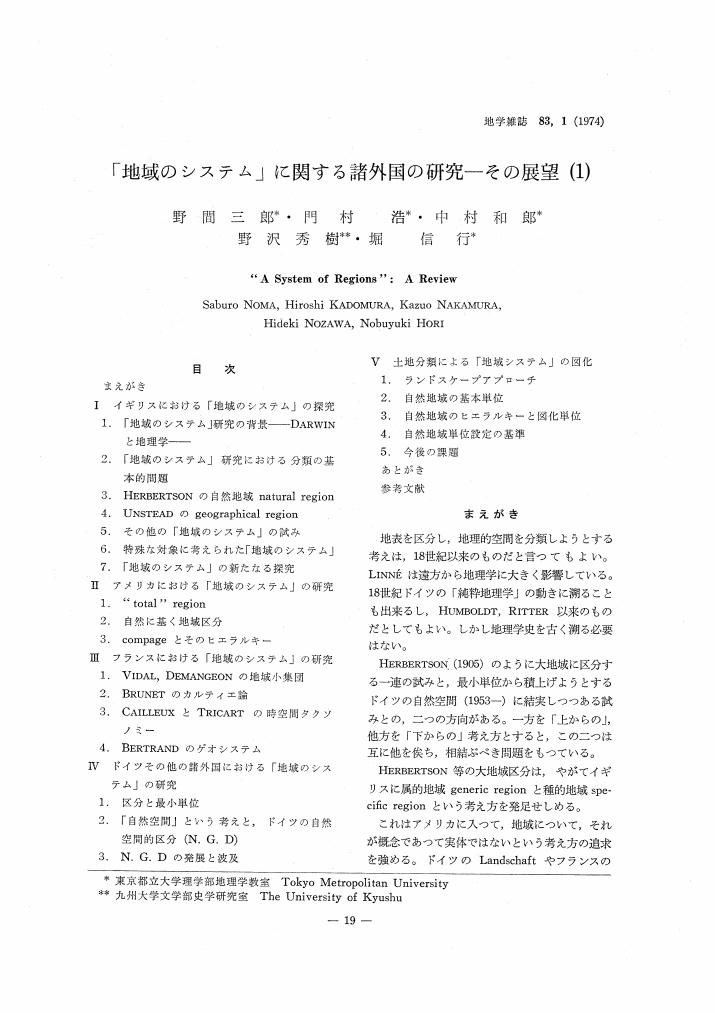8 0 0 0 OA IV 日本の現代地理学の回復と展望
3 0 0 0 OA 扇状地データベース
- 著者
- 小口 高 斉藤 享治 原 美登里 門村 浩 林 舟
- 出版者
- 公益社団法人 東京地学協会
- 雑誌
- 地学雑誌 (ISSN:0022135X)
- 巻号頁・発行日
- vol.109, no.1, pp.120-125, 2000-02-25 (Released:2010-10-13)
- 参考文献数
- 18
Data for Japanese alluvial fans have been made available on the Internet using ArcView IMS, a GIS-based map server software package. This system permits easy on-line browsing of the data from anywhere in the world and the creation of thematic maps at various scales for the area around an alluvial fan.
2 0 0 0 OA 砂漠化研究の系譜と課題
- 著者
- 門村 浩
- 出版者
- 公益社団法人 日本地理学会
- 雑誌
- 地理学評論 Ser. A (ISSN:00167444)
- 巻号頁・発行日
- vol.61, no.2, pp.205-228, 1988-02-01 (Released:2008-12-25)
- 参考文献数
- 179
- 被引用文献数
- 1 1
This paper reviews geographical studies of desertification, one of major global environmental issues in this century, in a historical perspective. Mention is made of the present status and future tasks of Japanese studies on this topic. Studies of desertification can date back to the early 20th century when a debate on the question of “progressive desiccation” and “desert encroachment” on the southern margin of the Sahara was of major concern among French and English geographers. Among others, following two scientists must be noted as the founders of desertification.studies: E. P. Stebbing (1935), English forestry professor who first stressed the spreading of desert conditions and the role of man in environmental deterioration, and A. Aubreville (1949), French ecologist and plant geographer who first used the term “desertification” in his book and persisted in his opinion of the creation of desert-like conditions due to human activities. Since the early 1970s, when the “Drought in Africa” reached its first culmination, studies on desertification issue, including those by geographers, have been accelerated. The U. N. Conference on Desertification (UNCOD) held in Nairobi in 1977, with the “Drought in Africa” in the backdrop, had drawn the widespread attention of the public and scientists. The activities of world geographers, in particular those organized in the IGU Working Group on Desertification in and around Arid Lands (1972-80), had served great deal in the preparation of the UNCOD and the Plan of the Action to Combat Desertification (PACD), the major product of the UNCOD, by presenting background documents and case studies. Since 1980, international cooperative research on arid lands within the IGU has been succeeded by the Working Group on Resources Management in Drylands. Recent activities of geographers in and outside of the Working Group have contributed to the implementation of and the assessment of the progress of the PACD. One of the recent trends in the desertification studies is the prevalent attention to the geopolitical approach to the problems of poverty and famine, and the transfer of strategies to combat desertification applied in one region to other regions. In Japan, overseas research in and and semi-arid lands began as early as the mid-1960s, but the attention to the desertification issue by geographers did not grow until the early 1980s. However, a number of studies in the and to humid regions of the world by Japanese geographers have been more or less related to the desertification phenomenon in a broad sense, i, e. soil erosion, vegetation degradation, water logging and salinization of irrigated lands, etc. With the “Crisis of Africa” resulting from the second culmination of persistent drought and desertification in the early 1980s in the background, the above studies were brought together into the Symposium on the Geography of Desertification held in September 1986. The papers presented at the symposium and published in this special issue have revealed rapid progress in the desertification studies in Japan in the last years. However, Japanese studies are still young, and following should be reinforced for further development of desertification studies. 1) Clima.tological and meteorological studies on the causes and effects of drought at various scales. 2) Comparative studies between regions under different climatic conditions as well as under different political and socioeconomic conditions. 3) Studies of human aspects in relation to the problems of poverty, population growth, famine, energy supply, etc.
1 0 0 0 OA 「地域のシステム」に関する諸外国の研究-その展望 (2)
- 著者
- 野間 三郎 門村 浩 中村 和郎 野沢 秀樹 堀 信行
- 出版者
- Tokyo Geographical Society
- 雑誌
- 地学雑誌 (ISSN:0022135X)
- 巻号頁・発行日
- vol.83, no.2, pp.103-124, 1974-04-25 (Released:2010-02-25)
- 参考文献数
- 157
1 0 0 0 OA 「地域のシステム」に関する諸外国の研究-その展望 (1)
- 著者
- 野間 三郎 門村 浩 中村 和郎 野沢 秀樹 堀 信行
- 出版者
- Tokyo Geographical Society
- 雑誌
- 地学雑誌 (ISSN:0022135X)
- 巻号頁・発行日
- vol.83, no.1, pp.19-37, 1974-02-25 (Released:2009-11-12)
- 被引用文献数
- 1
1 0 0 0 <記念論文>熱帯アフリカの「砂漠化」 : 新たな対応へ向けて
- 著者
- 門村 浩
- 出版者
- 学術雑誌目次速報データベース由来
- 雑誌
- 季刊地理学 (ISSN:09167889)
- 巻号頁・発行日
- vol.50, no.4, pp.287-295, 1998
- 参考文献数
- 18
- 被引用文献数
- 1 1
サハラ南縁地帯をはじめ, 世界の発展途上乾燥地域における人類生存を脅かしてきた「砂漠化」と干ばつ影響に対する, 国際協力による対応活動は, 新たな局面を迎えている。コミュニティ・レベルの, 住民参加とNGOの支援を基調とする, 総合的・持続的発展計画の一環としての「砂漠化」対策の推進を目的とする『国連砂漠化対処条約』が発効 (1996年12月) したからである。この新たな対応戦略に対し, 我が国が実質的な貢献をなすために必要とされる前提条件を示し, 当面, 重点的に取り組むべき課題として, 現場レベルのモニタリングと評価, 社会経済的側面の重視, NGOとCBOの活動支援強化, 地域特性への配慮, プロジェクトの調整と重複の排除, 対処能力の向上と技術移転, 気候変動予測と食糧安全保障, 専門家の養成などの問題を取り上げて議論した。また, これらに対する地理学からの積極的なコミットを期待した。
1 0 0 0 IR "農業優等国"カメルーン(近況・随筆)
- 著者
- 門村 浩
- 出版者
- お茶の水地理学会
- 雑誌
- お茶の水地理 (ISSN:02888726)
- 巻号頁・発行日
- vol.29, pp.96-96, 1988-05-06


